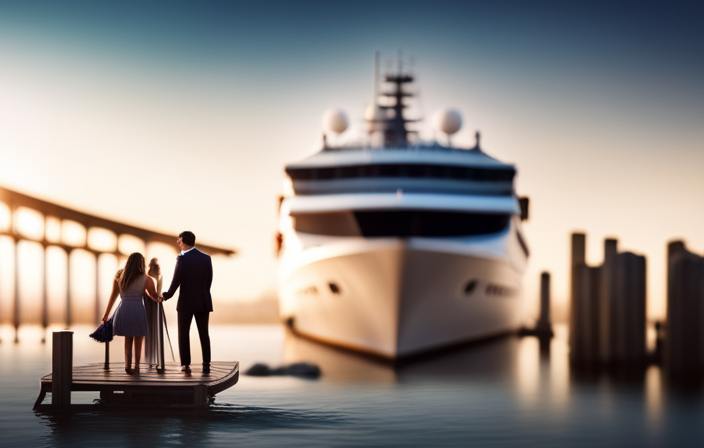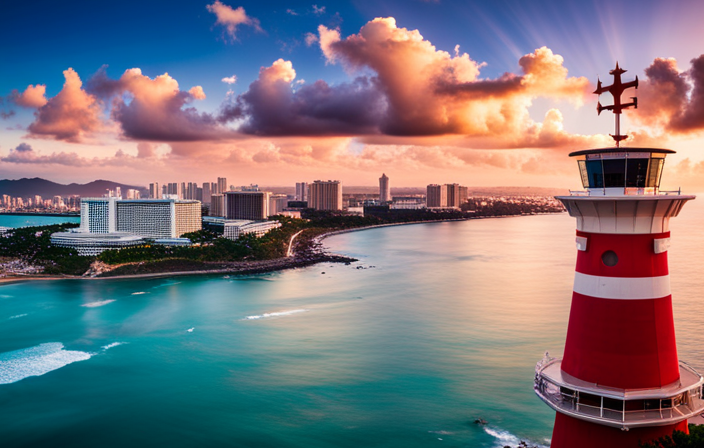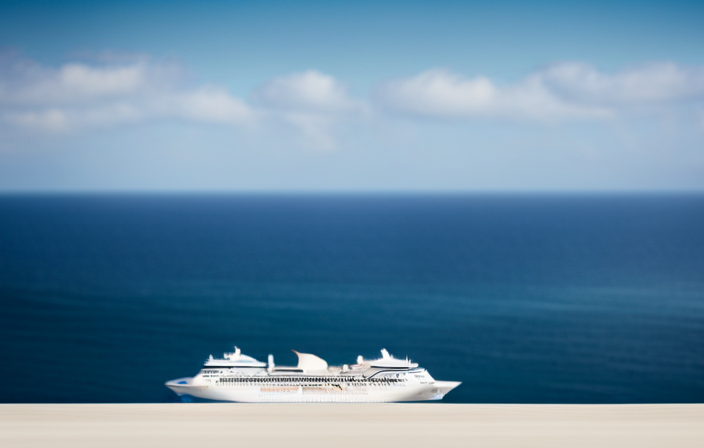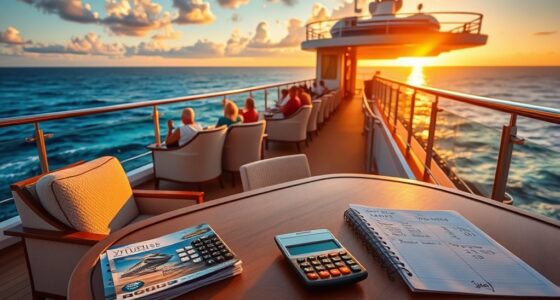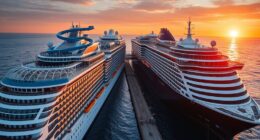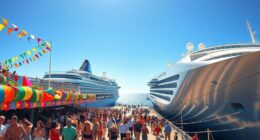Picture yourself on the wide deck of a luxurious ship, enveloped by the shimmering blue sea stretching out to the horizon. A soft breeze caresses your face, filling you with a sense of excitement and serenity. It’s a aspiration shared by many – the desire to own a cruise ship.
But before we embark on this maritime journey, we must first ask ourselves: how much does it cost to buy a cruise ship?
In this article, I will dive into the financial aspects of owning a cruise ship, exploring not only the initial purchase price but also the ongoing expenses that come with such an investment. From maintenance and repairs to crew salaries and benefits, fuel costs to insurance and legal fees – there is a plethora of factors to consider when calculating the true cost.
So grab your life jacket and join me as we navigate through the monetary depths of owning a cruise ship.
Key Takeaways
- Marketing campaigns play a crucial role in promoting cruise ships, utilizing various channels such as print and digital media, partnerships with travel agents and online booking platforms, social media, and targeted email campaigns.
- Understanding port fees and taxes is essential for evaluating the financial feasibility of owning a cruise ship, as these costs are calculated based on vessel size, tonnage, and duration of stay, and can vary depending on the location and popularity of ports.
- Miscellaneous expenses, including outfitting the vessel with luxurious amenities and generating revenue through shore excursions, significantly contribute to the overall cost of owning a cruise ship and should not be overlooked in the evaluation process.
- Evaluating upfront expenses, such as the initial price of purchasing a cruise ship, along with ongoing operational outlays and potential tax deductions, is necessary to determine the financial feasibility and overall investment of owning a cruise ship.
Initial Purchase Price
If you’re considering purchasing a cruise ship, you’ll need to be prepared for the substantial initial cost that comes with it. The purchase price of a cruise ship can vary greatly depending on factors such as size, age, and condition.
On average, a new cruise ship can cost anywhere from $500 million to over $1 billion. However, there are also options to purchase used ships at a lower price point, typically ranging from $100 million to $300 million.
It’s important to note that in addition to the initial purchase price, there are other costs to consider such as the cost of refurbishment and financing options. These additional expenses can significantly impact the overall investment required.
Once you’ve acquired the ship, maintenance and repairs become an ongoing necessity for smooth operation without interruption.
Maintenance and Repairs
Maintaining and repairing a cruise ship can sometimes be like navigating a stormy sea. It requires constant attention and investment. Cruise ships are no small feat when it comes to maintenance costs. These behemoths of the seas require regular inspections, routine servicing, and preventive measures to ensure smooth sailing for passengers.
On average, maintenance costs for a cruise ship can range from $1 million to $3 million per year. This includes expenses related to hull cleaning, engine overhauls, electrical system updates, and safety equipment replacements.
Furthermore, repair expenses can add up quickly in case of unforeseen damages or accidents. From fixing propulsion systems to repairing plumbing issues or replacing damaged furnishings, these repairs can cost anywhere from hundreds of thousands to millions of dollars.
As we transition into discussing crew salaries and benefits, one thing is clear: maintaining a cruise ship is not for the faint-hearted nor the shallow-pocketed.
Crew Salaries and Benefits
Get ready to experience the incredible dedication and hard work of the cruise ship crew, who tirelessly serve you with passion and ensure your every need is met. The crew members are the backbone of a successful cruise operation, but their salaries and benefits contribute significantly to the overall cost of owning a cruise ship.
Crew turnover is an important factor to consider when calculating crew-related expenses. High turnover rates can lead to increased recruitment and training costs. To mitigate this, cruise lines invest heavily in crew training programs that aim to enhance skills and retain experienced staff. These programs cover various areas such as customer service, safety protocols, emergency response, and language proficiency.
Additionally, competitive salaries and comprehensive benefits packages are provided to attract and retain qualified crew members. These packages often include healthcare coverage, retirement plans, vacation time, housing accommodations, meals onboard, and even educational opportunities for career advancement.
As we transition into discussing fuel and operational costs in the next section…
Fuel and Operational Costs
Fuel and operational costs are substantial components in the overall expense of owning and operating a cruise ship. Fuel efficiency plays a crucial role in managing these costs effectively. By employing advanced technologies such as hybrid propulsion systems or using alternative fuels like liquefied natural gas (LNG), cruise lines can enhance their fuel efficiency, thereby reducing both financial expenditures and environmental impact. These measures not only contribute to cost savings but also align with the industry’s commitment to sustainability.
As we delve into insurance and legal expenses, it becomes evident that careful consideration of fuel choices is just one aspect of successfully managing the myriad costs associated with owning a cruise ship.
Insurance and Legal Expenses
Navigating the treacherous waters of insurance and legal expenses can be like charting a course through a dense fog, but understanding and managing these crucial aspects is essential for smooth sailing in the cruise ship industry.
When it comes to insurance coverage, there are several key areas that need to be considered:
-
Liability Insurance: This provides protection against claims arising from personal injury or property damage caused by the cruise ship or its crew.
-
Hull Insurance: This covers physical damage to the ship itself, including repairs or replacement in case of accidents or natural disasters.
-
Workers’ Compensation Insurance: As an employer, it is necessary to provide coverage for workers in case of injuries or illnesses that occur while on duty.
-
Legal Regulations: Cruise ships must comply with various legal requirements related to safety standards, environmental regulations, and passenger rights.
Understanding these insurance coverages and legal regulations is vital for ensuring compliance and mitigating risks in the cruise ship industry.
Transitioning into the subsequent section about ‘food and beverage supplies,’ careful planning and management are also essential when it comes to meeting the needs of passengers onboard without compromising quality or efficiency.
Food and Beverage Supplies
Sailing through the culinary seas and satisfying the cravings of hungry passengers is like orchestrating a symphony of flavors. Quenching their thirst with delightful concoctions adds to the experience. Catering services play a crucial role in food and beverage supplies on a cruise ship. They are responsible for menu planning and ensuring a wide variety of delicious options to suit diverse tastes. Working closely with suppliers, they source high-quality ingredients while keeping costs in check. Efficient inventory management minimizes waste and maximizes profitability. By analyzing passenger preferences and trends, catering services optimize menu offerings to enhance guest satisfaction and increase revenue.
Transitioning into the next section about onboard entertainment and activities, ensuring an exceptional dining experience complements the overall enjoyment of passengers aboard our cruise ship.
Onboard Entertainment and Activities
Immerse yourself in a world of excitement and endless possibilities as you explore the onboard entertainment and activities available to you.
On a cruise ship, there is never a dull moment with an array of live performances that cater to all tastes. From Broadway-style shows to comedy acts and musical concerts, there is something for everyone to enjoy.
The recreational facilities onboard are equally impressive, with state-of-the-art gyms, swimming pools, sports courts, and even rock climbing walls. You can stay active or simply relax by indulging in spa treatments or lounging by the poolside.
Engage in thrilling water slides or challenge your friends to a game of mini-golf on the upper deck.
As we transition into the next section about ‘marketing and advertising,’ it becomes evident that these enticing entertainment options play a crucial role in attracting passengers from all around the world.
Marketing and Advertising
Get ready to be captivated by the world of marketing and advertising as you discover the innovative strategies used to entice travelers like yourself to embark on an unforgettable vacation.
Cruise ships employ a variety of marketing strategies to reach their target audience effectively. They conduct thorough target audience analysis, gathering demographic data such as age, income level, and lifestyle preferences. This information helps them tailor their advertisements and promotions to appeal directly to potential customers who are most likely to be interested in cruising.
Marketing campaigns for cruise ships often include a combination of traditional print and digital media, as well as strategic partnerships with travel agents and online booking platforms. Social media plays a significant role in reaching out to younger audiences, while targeted email campaigns engage past customers with exclusive offers.
Port Fees and Taxes
Embarking on a cruise journey opens the gateway to a realm where each port visit brings forth not only unique experiences but also a hidden world of port fees and taxes that add an intriguing layer to your voyage. Understanding how these costs are calculated is crucial in determining the financial feasibility of owning a cruise ship.
To calculate port fees, several factors come into play such as the size and tonnage of the vessel, the duration of stay at each port, and any additional services required. These fees can vary significantly depending on the location and popularity of the ports visited.
Tax deductions for cruise ships can provide some relief from these expenses. Depending on the country or region where your ship is registered, there may be tax incentives available for owners, including deductions for fuel consumption, maintenance costs, and crew wages.
Considering both port fees calculation and potential tax deductions is essential when evaluating the overall cost of buying a cruise ship. Now let’s delve into another aspect: miscellaneous expenses…
Miscellaneous Expenses
When considering the cost of purchasing a cruise ship, it is essential to take into account not only the initial price but also the miscellaneous expenses that come along with it. These additional costs can significantly impact the overall investment and should not be overlooked.
One major aspect that adds to the expense is cruise ship accommodations. These include outfitting the vessel with luxurious cabins, dining facilities, entertainment venues, and recreational areas. The quality of these amenities directly affects guest satisfaction and ultimately determines ticket prices.
Furthermore, shore excursions play a crucial role in attracting passengers and generating revenue. These activities allow guests to explore various destinations while providing an opportunity for additional spending on guided tours or adventurous experiences such as snorkeling or zip-lining.
Considering these factors when evaluating the cost of buying a cruise ship ensures a comprehensive understanding of both upfront expenses and ongoing operational outlays.
Frequently Asked Questions
How long does it take to build a cruise ship from scratch?
It typically takes several years to build a cruise ship from scratch. The construction timeline depends on various factors, including the complexity of the design and the shipbuilding process.
What is the average lifespan of a cruise ship?
On average, a cruise ship has a lifespan of 30-40 years before retirement. Maintenance plays a crucial role in prolonging their operational life. Regular inspections, repairs, and upgrades are necessary to ensure safety and meet industry standards.
Are there any restrictions on where a cruise ship can sail?
There are restrictions on cruise ship sailing routes and destinations. These limitations are determined by various factors such as international regulations, port infrastructure, environmental concerns, and geopolitical situations.
How many passengers can a cruise ship accommodate?
A cruise ship can accommodate a varying number of passengers, depending on its size and configuration. The passenger capacity ranges from a few hundred to several thousand, with different cabin sizes catering to various demographics of travelers.
What are the environmental regulations that cruise ships have to comply with?
Cruise ships must comply with environmental regulations to minimize their environmental impact. These include emission standards for air pollutants, wastewater treatment, and waste management. Meeting these regulations is crucial for sustainable operations in the cruise industry.
Can I Buy a Cruise Ship to the North Pole?
No, you cannot buy a cruise ship to the north pole. The extreme conditions and unpredictable ice make it nearly impossible for a cruise to the north pole. It’s best to experience the Arctic region on a specially designed icebreaker or expedition ship.
Conclusion
In conclusion, purchasing a cruise ship entails substantial costs beyond just the initial purchase price. With maintenance and repairs alone, owners can expect to spend millions of dollars annually.
Additionally, crew salaries and benefits, fuel and operational costs, insurance and legal expenses, onboard entertainment and activities, marketing and advertising efforts, as well as port fees and taxes all contribute to the overall expense.
It is worth noting that on average, fuel costs account for approximately 20% of a cruise ship’s total operating expenses. This statistic highlights the significant impact fuel prices have on the industry’s financials.

